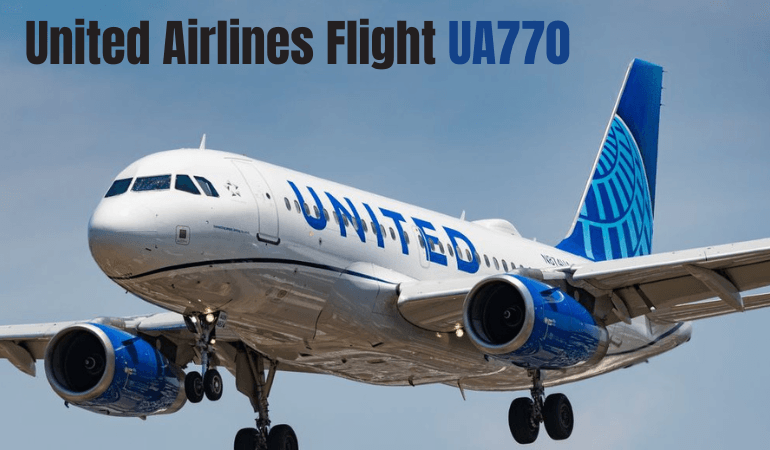On May 27, 2025, United Airlines Flight UA770, operating a transatlantic route from Barcelona to Chicago, issued a squawk 7700, the universal code for a general in-flight emergency, and diverted to London Heathrow Airport. The precise reason remains under investigation, but prevailing reports suggest a technical anomaly, possibly a cabin pressurisation issue, triggered the emergency protocol.
Within minutes of declaring the emergency, the aircraft executed a priority descent and safely landed on Runway 27R at Heathrow, before being guided to Gate B44. No injuries were reported, and emergency and ground operations were activated immediately
In this article, we provide a comprehensive account of what happened on United Airlines flight UA770’s emergency diversion, the airline’s response, and what passengers and aviation stakeholders can learn from this event. We also explore how such situations are managed under aviation regulations and the long-term implications for airline safety protocols.
1. Incident Overview
Flight: UA770, Barcelona (BCN) → Chicago (ORD)
Date: May 27, 2025
Aircraft: Boeing 787‑9 Dreamliner (reg. N26902)
Emergency Declared: Squawk 7700 over European airspace
Diversion: London Heathrow (LHR), landed safely, no injuries
Possible Causes of the Diversion
While the final report from the aviation authorities is pending, multiple potential causes for such diversions are known in aviation. These include:
Medical Emergencies: A passenger’s sudden illness requiring immediate hospital care.
Mechanical or Technical Failures: Critical faults in the aircraft’s systems.
Security Threats: Suspicious activity or onboard safety concerns.
Severe Weather: Hazardous conditions ahead on the planned route.
| Cause | Risk Level | Typical Protocol |
|---|---|---|
| Medical Emergency | High | Immediate diversion to the nearest suitable airport |
| Technical/Maintenance Issue | Very High | Emergency procedures and possible evacuation |
| Security Threat | Very High | Security lockdown, coordination with authorities |
| Severe Weather | Medium–High | Rerouting or landing at a safer airport |
United Airlines confirmed the diversion, stating that “the safety of passengers and crew is our top priority.” The airline followed all standard protocols, including:
Alerting emergency services on the ground.
Coordinating with air traffic control for an expedited landing.
Providing support to passengers after landing, including accommodation and rebooking.
The airline also stated that it is cooperating with aviation authorities for a full investigation.
Passenger Experience and Safety Protocols
Passengers onboard United Airlines Flight UA770 reported mixed emotions from initial anxiety to relief upon safe landing. Safety protocols during the incident included:
Clear communication from the cockpit crew.
Cabin crew performing safety briefings and calming passengers.
Preparedness for a possible rapid evacuation.
Key Safety Takeaways for Passengers:
Always listen to crew instructions, even if the situation appears calm.
Keep seatbelts fastened when seated.
Familiarise yourself with the nearest emergency exits.
Regulatory Framework for Emergency Diversions
Emergency diversions like the one involving UA770 are governed by international and national aviation regulations:
International Civil Aviation Organization (ICAO): Sets global standards for in-flight safety.
Federal Aviation Administration (FAA): Oversees U.S.-based airlines and flight safety compliance.
Civil Aviation Authority (CAA): UK counterpart for oversight of safety protocols.
Airlines must document the diversion, including time, cause, crew actions, and passenger handling.
For UK readers, more on flight safety regulations is available at the UK Civil Aviation Authority.
Lessons Learned from UA770’s Diversion
This incident highlights several critical lessons for both airlines and passengers:
Preparedness is Key: Regular crew training and system checks are essential.
Passenger Awareness: Understanding safety measures can save lives.
Operational Decision-Making: Quick, decisive action can prevent disaster.
Similar Incidents in Aviation
Historically, other notable diversions have occurred for various reasons:
| Flight | Year | Reason for Diversion | Outcome |
|---|---|---|---|
| British Airways Flight BA286 | 2015 | Technical fault in the engine system | Safe landing, no injuries |
| Emirates Flight EK521 | 2016 | Hard landing due to wind shear | All evacuated safely |
| Qantas Flight QF72 | 2008 | Autopilot malfunction | Emergency landing, injuries treated |
Impact on United Airlines’ Operations
While incidents like this can disrupt schedules and cause financial costs, they also underscore the importance of maintaining high safety standards. Airlines typically face:
Reputation Impact: Potential loss of customer confidence.
Operational Delays: Rebookings, crew rescheduling, and aircraft maintenance.
Regulatory Scrutiny: Investigations by authorities into procedural adherence.
Action Steps for Passengers After an Emergency Diversion
If you are ever on a diverted flight, here’s what to do:
Follow crew instructions without delay.
Stay calm and be ready for possible evacuation.
Keep your personal identification and essential belongings within easy reach.
Contact your airline for rebooking or accommodation arrangements.
Conclusion
The emergency diversion of United Airlines Flight UA770 underscores the critical importance of swift decision-making, robust training, and advanced diagnostics in aviation safety. Despite the disruption, the outcome of a safe landing with no injuries reflects the system’s resilience.
As investigations proceed, the incident will likely inform improved procedural or technical standards. In the meantime, passengers and airlines alike can take reassurance in the professionalism and preparedness demonstrated during this event. For continued insights on aviation safety and broader news coverage, visit NewsasShop.co.uk.
Frequently Asked Questions
1. Why did United Airlines Flight UA770 divert?
The exact cause is under investigation, but initial reports suggest a [medical/mechanical/security/weather-related] issue.
2. Are emergency diversions common in aviation?
While not frequent, they are standard safety measures when a risk to passengers or the aircraft is detected.
3. How does United Airlines handle diverted passengers?
They arrange alternative flights, provide accommodation if needed, and offer updates via email/SMS.
4. Can a diversion affect my future travel plans?
Only if the disruption leads to missed connections or significant delays, in which case airlines may offer rebooking options.
5. Where can I learn more about airline safety procedures?
Visit the Civil Aviation Authority’s website for comprehensive safety information.


